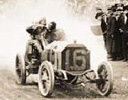|
Instructions to Operators
1—Keep to the Right when being overtaken.
2—Keep to the Left when overtaking.
3—Give due warning of your approach, by horn or trumpet.
4—Motor exhausts must not be directed toward the ground.
5—Stop on the tape when entering a control.
6—Start, standing, from tape when leaving a control.
7—No supplies of oil, water, fuel, or batteries can be taken on board while in control.
8—No repairs to tires, cars, or equipment can be made while in control.
9—Start from standstill.
10—Finish at speed.
11—Numbers will be drawn Saturday, October 1, 1904, at 8 p.m., at the rooms of the
A.A.A., 753 Fifth Avenue, New York.
12—At the time numbers are drawn, the assignments on instant of start will be made. Your
time will be taken from that instant whether you start or not (see Condition 21).
Instructions for Judges at Controls
1—Keep in close touch with the official timers, one at the entrance, and one at the exit.
2—Allow no supplies to be put on board while in control. No repairs to tires, cars or
equipment allowed.
3—See that a pilot accompanies (precedes) each car.
4—See that competitors follow the pilots from entrance to exit.
5—See that Timer's card is deposited in time check box before the car leaves the control.
6—See that the card is signed by both Timers before it is deposited.
7—Make sure that no equipment is discarded while in control.
8—Report promptly to the Referee, by telephone, any irregularity, or accident to car or
operator.
9—Have time of arrival and departure immediately reported, by telephone, to the scorers
at the starting line.
10—Cars must come to dead stop at entrance (take time then).
11—Cars must start (standing, from tape) from exit.
Instructions to Mounted Judges and Checkers
1—Cover your patrol station in both directions.
2—Watch carefully that the barricaded highways are not used.
3—Check on your card each car as it passes each time.
4—Keep well out of the way of the contestants.
5—At the conclusion of the race, go to the nearest turn, telephone the Judges, and when
instructed collect from the Judges at turns their reports, seeing that they are signed, and the location given.
6—Go to the nearest control station, telephone the Judges, and when instructed, collect
from the Timers and Judges at control stations their reports, seeing that they are duly signed by the proper
officials.
7—At the earliest moment, after collecting these reports, proceed with expedition to the
Garden City Hotel, and deliver all reports (your own, Judges at turn, and Timers and Judges) to the Chairman of the
Racing Board at the Board's headquarters.
Instructions to Special Officers at Highway Crossings
1—Allow no vehicle to cross or enter upon the course.
2—Allow no children to cross or enter upon the course.
3—Allow no dogs, fowls or animals to cross or enter upon the course.
4—Caution all adults that crossing or entering upon the course is dangerous.
5—Roads will be closed until 3 o'clock.
6—If you need assistance call upon the mounted patrol officers, who will patrol the course,
mounted on motor bicycles.
7—In case a runaway horse gets on the course, use your red flag to warn the racers.
8—Waving your white flag, or keeping it in view, serves to remind them that the course is
clear.
9—Remind all observers that it is unsafe to get beyond the curb line, and that
they will see as much if they seat themselves on fences, and they will be safe.
10—The racing cars will be traveling at the rate of about a mile to the minute, and it is
sure death to get in the way of one.
11—If the foregoing are observed there need be no fear of an accident.
Rules for the first Vanderbilt Cup race.
|



